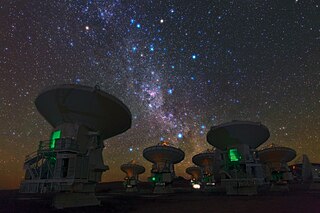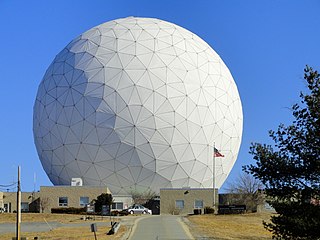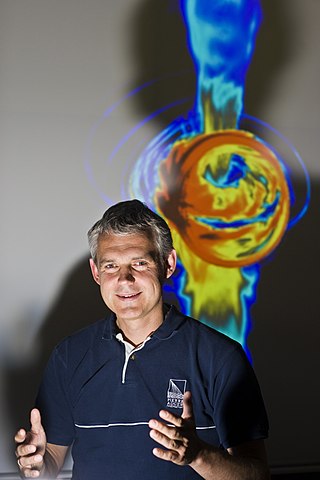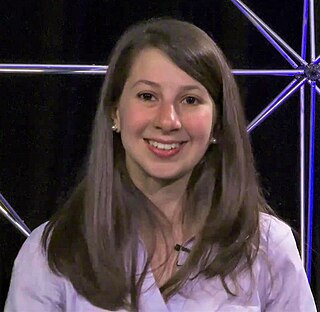
A black hole is a region of spacetime where gravity is so strong that nothing, not even light and other electromagnetic waves, is capable of possessing enough energy to escape it. Einstein's theory of general relativity predicts that a sufficiently compact mass can deform spacetime to form a black hole. The boundary of no escape is called the event horizon. A black hole has a great effect on the fate and circumstances of an object crossing it, but it has no locally detectable features according to general relativity. In many ways, a black hole acts like an ideal black body, as it reflects no light. Quantum field theory in curved spacetime predicts that event horizons emit Hawking radiation, with the same spectrum as a black body of a temperature inversely proportional to its mass. This temperature is of the order of billionths of a kelvin for stellar black holes, making it essentially impossible to observe directly.

Messier 87 is a supergiant elliptical galaxy in the constellation Virgo that contains several trillion stars. One of the largest and most massive galaxies in the local universe, it has a large population of globular clusters—about 15,000 compared with the 150–200 orbiting the Milky Way—and a jet of energetic plasma that originates at the core and extends at least 1,500 parsecs, traveling at a relativistic speed. It is one of the brightest radio sources in the sky and a popular target for both amateur and professional astronomers.

Very-long-baseline interferometry (VLBI) is a type of astronomical interferometry used in radio astronomy. In VLBI a signal from an astronomical radio source, such as a quasar, is collected at multiple radio telescopes on Earth or in space. The distance between the radio telescopes is then calculated using the time difference between the arrivals of the radio signal at different telescopes. This allows observations of an object that are made simultaneously by many radio telescopes to be combined, emulating a telescope with a size equal to the maximum separation between the telescopes.

A supermassive black hole is the largest type of black hole, with its mass being on the order of hundreds of thousands, or millions to billions, of times the mass of the Sun (M☉). Black holes are a class of astronomical objects that have undergone gravitational collapse, leaving behind spheroidal regions of space from which nothing can escape, including light. Observational evidence indicates that almost every large galaxy has a supermassive black hole at its center. For example, the Milky Way galaxy has a supermassive black hole at its center, corresponding to the radio source Sagittarius A*. Accretion of interstellar gas onto supermassive black holes is the process responsible for powering active galactic nuclei (AGNs) and quasars.

3C 279 is an optically violent variable quasar (OVV), which is known in the astronomical community for its variations in the visible, radio and x-ray bands. The quasar was observed to have undergone a period of extreme activity from 1987 until 1991. The Rosemary Hill Observatory (RHO) started observing 3C 279 in 1971, the object was further observed by the Compton Gamma Ray Observatory in 1991, when it was unexpectedly discovered to be one of the brightest gamma ray objects in the sky. It is also one of the brightest and most variable sources in the gamma ray sky monitored by the Fermi Gamma-ray Space Telescope. It was used as a calibrator source for Event Horizon Telescope observations of M87* that resulted in the first image of a black hole.

Sagittarius A*, abbreviated as Sgr A*, is the supermassive black hole at the Galactic Center of the Milky Way. Viewed from Earth, it is located near the border of the constellations Sagittarius and Scorpius, about 5.6° south of the ecliptic, visually close to the Butterfly Cluster (M6) and Lambda Scorpii.
Aperture synthesis or synthesis imaging is a type of interferometry that mixes signals from a collection of telescopes to produce images having the same angular resolution as an instrument the size of the entire collection. At each separation and orientation, the lobe-pattern of the interferometer produces an output which is one component of the Fourier transform of the spatial distribution of the brightness of the observed object. The image of the source is produced from these measurements. Astronomical interferometers are commonly used for high-resolution optical, infrared, submillimetre and radio astronomy observations. For example, the Event Horizon Telescope project derived the first image of a black hole using aperture synthesis.

Haystack Observatory is a multidisciplinary radio science center, ionospheric observatory, and astronomical microwave observatory owned by Massachusetts Institute of Technology (MIT). It is in Westford, Massachusetts, in the United States, about 45 kilometers (28 mi) northwest of Boston. The observatory was built by MIT's Lincoln Laboratory for the United States Air Force and was called the Haystack Microwave Research Facility. Construction began in 1960, and the antenna began operating in 1964. In 1970 the facility was transferred to MIT, which then formed the Northeast Radio Observatory Corporation (NEROC) with other universities to operate the site as the Haystack Observatory. As of January 2012, a total of nine institutions participated in NEROC.

OJ 287 is a BL Lac object 4 billion light-years from Earth that has produced quasi-periodic optical outbursts going back approximately 120 years, as first apparent on photographic plates from 1891. Seen on photographic plates since at least 1887, it was first detected at radio wavelengths during the course of the Ohio Sky Survey. It is a supermassive black hole binary (SMBHB). The intrinsic brightness of the flashes corresponds to over a trillion times the Sun's luminosity, greater than the entire Milky Way galaxy's light output.
The CLEAN algorithm is a computational algorithm to perform a deconvolution on images created in radio astronomy. It was published by Jan Högbom in 1974 and several variations have been proposed since then.
The Event Horizon Telescope (EHT) is a telescope array consisting of a global network of radio telescopes. The EHT project combines data from several very-long-baseline interferometry (VLBI) stations around Earth, which form a combined array with an angular resolution sufficient to observe objects the size of a supermassive black hole's event horizon. The project's observational targets include the two black holes with the largest angular diameter as observed from Earth: the black hole at the center of the supergiant elliptical galaxy Messier 87, and Sagittarius A*, at the center of the Milky Way.

Heino Falcke is a German professor of radio astronomy and astroparticle physics at the Radboud University Nijmegen (Netherlands). His main field of study is black holes, and he is the originator of the concept of the 'black hole shadow'. In 2019, Falcke announced the first Event Horizon Telescope results at the EHT Press Conference in Brussels.
William T. Freeman is the Thomas and Gerd Perkins Professor of electrical engineering and computer science at the Massachusetts Institute of Technology. He is known for contributions to computer vision.
Larry Lindsey Kimura was born in Waimea, Hawaii County, Hawaii, U.S.A., between his Nisei father Hisao Kimura, who had immigrated from Hiroshima, Japan, and his Hawaiian mother, Elizabeth Lindsey, who had been brought up in a predominantly Hawaiian-speaking family.

Luciano Rezzolla is an Italian professor of relativistic astrophysics and numerical relativity at the Goethe University Frankfurt. His main field of study is the physics and astrophysics of compact objects such as black holes and neutron stars. It was announced in 2019 that he had been appointed honorary Andrews Professor of Astronomy at Trinity College Dublin (TCD).

Katherine Louise Bouman is an American engineer and computer scientist working in the field of computational imaging. She led the development of an algorithm for imaging black holes, known as Continuous High-resolution Image Reconstruction using Patch priors (CHIRP), and was a member of the Event Horizon Telescope team that captured the first image of a black hole.
Jan Arvid Högbom is a Swedish radio astronomer and astrophysicist.
Charles Addison Bouman Jr. is the Showalter Professor of Electrical and Computer Engineering and Biomedical Engineering at Purdue University, where he has taught since 1989. His research focuses on applications of image processing in various contexts, including medicine, materials science, and consumer imaging. His work led to the development of the first commercial CT scan technology to use model-based iterative reconstruction. He is a co-inventor on over fifty patents in the field of consumer imaging. He is a member of the National Academy of Inventors, as well as a fellow of the Institute of Electrical and Electronics Engineers, the American Institute for Medical and Biological Engineering, the Society for Imaging Science and Technology, and SPIE. He was formerly the editor-in-chief of IEEE Transactions on Image Processing.
Sheperd "Shep" S. Doeleman is an American astrophysicist. His research focuses on super massive black holes with sufficient resolution to directly observe the event horizon. He is a senior research fellow at the Center for Astrophysics | Harvard & Smithsonian and the Founding Director of the Event Horizon Telescope (EHT) project. He led the international team of researchers that produced the first directly observed image of a black hole.

Ramesh Narayan is an Indian-American theoretical astrophysicist, currently the Thomas Dudley Cabot Professor of the Natural Sciences in the Department of Astronomy at Harvard University. Full member of the National Academy of Sciences, Ramesh Narayan is widely known for his contributions on the theory of black hole accretion processes. He is involved in the Event Horizon Telescope project, which led in 2019 to the first image of the event horizon of a black hole.











